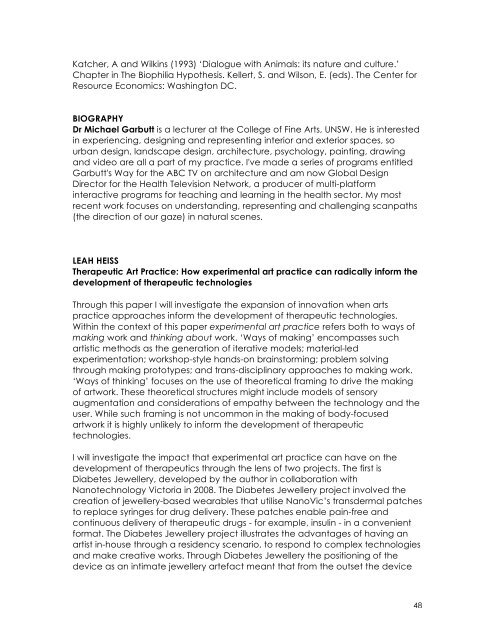main conference abstracts & biographies - University of New South ...
main conference abstracts & biographies - University of New South ...
main conference abstracts & biographies - University of New South ...
Create successful ePaper yourself
Turn your PDF publications into a flip-book with our unique Google optimized e-Paper software.
Katcher, A and Wilkins (1993) ‘Dialogue with Animals: its nature and culture.’<br />
Chapter in The Biophilia Hypothesis. Kellert, S. and Wilson, E. (eds). The Center for<br />
Resource Economics: Washington DC.<br />
BIOGRAPHY<br />
Dr Michael Garbutt is a lecturer at the College <strong>of</strong> Fine Arts, UNSW. He is interested<br />
in experiencing, designing and representing interior and exterior spaces, so<br />
urban design, landscape design, architecture, psychology, painting, drawing<br />
and video are all a part <strong>of</strong> my practice. I've made a series <strong>of</strong> programs entitled<br />
Garbutt's Way for the ABC TV on architecture and am now Global Design<br />
Director for the Health Television Network, a producer <strong>of</strong> multi-platform<br />
interactive programs for teaching and learning in the health sector. My most<br />
recent work focuses on understanding, representing and challenging scanpaths<br />
(the direction <strong>of</strong> our gaze) in natural scenes.<br />
LEAH HEISS<br />
Therapeutic Art Practice: How experimental art practice can radically inform the<br />
development <strong>of</strong> therapeutic technologies<br />
Through this paper I will investigate the expansion <strong>of</strong> innovation when arts<br />
practice approaches inform the development <strong>of</strong> therapeutic technologies.<br />
Within the context <strong>of</strong> this paper experimental art practice refers both to ways <strong>of</strong><br />
making work and thinking about work. ‘Ways <strong>of</strong> making’ encompasses such<br />
artistic methods as the generation <strong>of</strong> iterative models; material-led<br />
experimentation; workshop-style hands-on brainstorming; problem solving<br />
through making prototypes; and trans-disciplinary approaches to making work.<br />
‘Ways <strong>of</strong> thinking’ focuses on the use <strong>of</strong> theoretical framing to drive the making<br />
<strong>of</strong> artwork. These theoretical structures might include models <strong>of</strong> sensory<br />
augmentation and considerations <strong>of</strong> empathy between the technology and the<br />
user. While such framing is not uncommon in the making <strong>of</strong> body-focused<br />
artwork it is highly unlikely to inform the development <strong>of</strong> therapeutic<br />
technologies.<br />
I will investigate the impact that experimental art practice can have on the<br />
development <strong>of</strong> therapeutics through the lens <strong>of</strong> two projects. The first is<br />
Diabetes Jewellery, developed by the author in collaboration with<br />
Nanotechnology Victoria in 2008. The Diabetes Jewellery project involved the<br />
creation <strong>of</strong> jewellery-based wearables that utilise NanoVic’s transdermal patches<br />
to replace syringes for drug delivery. These patches enable pain-free and<br />
continuous delivery <strong>of</strong> therapeutic drugs - for example, insulin - in a convenient<br />
format. The Diabetes Jewellery project illustrates the advantages <strong>of</strong> having an<br />
artist in-house through a residency scenario, to respond to complex technologies<br />
and make creative works. Through Diabetes Jewellery the positioning <strong>of</strong> the<br />
device as an intimate jewellery artefact meant that from the outset the device<br />
48



